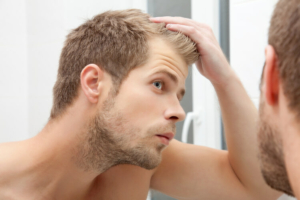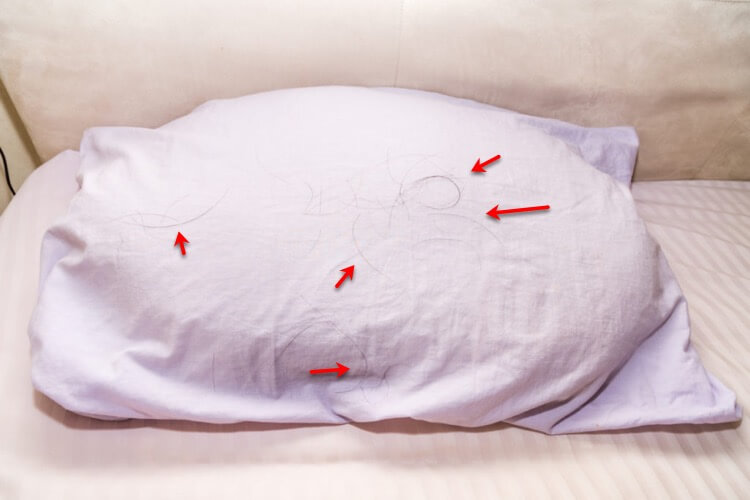How to Talk to Your Partner About Hair Loss

Talking to your partner about hair loss can be tricky. What are you supposed to say? “Have you noticed that your hairline is receding?” After all, your significant other may be embarrassed, or be ignoring the issue. They may also fall into the category of people who genuinely don’t care about their appearances. Not to mention that you don’t accidentally want your partner to question whether or not you find them attractive. Aargh. Maybe you’re better off not saying anything?
Well, that depends on your approach. If you are supportive, raising the topic can be helpful. You can help your partner feel better, and you can also help give him or her the confidence needed to get treatment. Remember, it’s not what you say, but how you say it. Let’s talk about the best way to start the discussion.
Remember that Timing is Everything
Has your partner said anything about their hair loss? Made any jokes? If so, he or she is opening the floor to a conversation. Be careful not to raise the topic out of the blue or force the conversation. Doing so may make your partner feel awkward. You want to calm any insecurities rather than fuel them. What if they don’t give you an in? They just may not be ready to talk about it. Leave the topic alone for now and see if it comes up later.
Show Empathy
If you and your partner do discuss their hair loss, keep in mind that your partner may be feeling a whole array of emotions. Getting older, no longer being desirable, and fear of losing control over one’s body can go hand-in-hand with male pattern baldness, female pattern baldness, or other types of alopecia. Yes, these emotions are real and can be challenging to overcome. After all, hair is a big part of our physical identity. It’s not uncommon to refer to a person as the “guy with the blonde spiky hair” or the “woman with the long, dark, wavy hair.”
How can you approach the topic in a way that won’t diminish these feelings? Remember that compassion goes a long way. One way to do that is to acknowledge your partner’s grief. Let them know that you understand hair loss is upsetting and that you care. Avoid statements such as “maybe it will grow back” that invalidate their feelings. You may also want to ask whether your partner wants you to just listen or if he or she wants your input. Unsolicited advice may not be welcome.
Do Your Homework
If your partner does want advice, you’ll want to be prepared. Here are a few points that will be helpful to know. First of all, the most common reason why people lose their hair is typically due to androgenetic alopecia (male or female pattern baldness). It’s a genetic condition that occurs when a person’s body converts Testosterone to a substance called Dihydrotestosterone or DHT. DHT attacks the hair follicles, causing them to shrink and eventually close up. Existing hair sheds and new hair fails to grow. Many people don’t realize that androgenetic alopecia can be treated.
Minoxidil, known as Rogaine, is often used to keep hair follicles open. Finasteride or Dutasteride, DHT blockers, can be prescribed and used simultaneously. If your significant other is a guy and is concerned about sexual side effects, you can tell him not to worry. Pills are what can cause side effects. Topical formulas, which are just as effective, don’t carry the same risk profile. (01) Women don’t carry the same risk profile, although Finasteride and Dutasteride should only be used by women who aren’t pregnant or thinking about becoming pregnant.
Although male and female pattern baldness is the predominant type of alopecia that men and women experience, it’s not the only type. They can also experience temporary hair loss from illnesses or stressful events, alopecia areata, lichen planopilaris, and other types of alopecia. A trip to the dermatologist is the best way to find out for sure what kind of alopecia your partner has.
Offer Reassurance
Your partner may or may not decide to seek treatment for their hair loss. No matter where they stand on the topic, it’s important to let them know that their decision is okay with you. Self-confidence is what matters.
Build a Healthy Lifestyle
Does your partner eat right, exercise, or take any necessary supplements? If not, now is the time to make lifestyle changes that can promote healthier hair. Smoking, too much alcohol, poor diet, and stress all contribute to hair loss. As a couple, you have an automatic built-in support system to improve any bad habits. As a matter of fact, couples who quit smoking together are 5.83 times more likely to succeed than when only one partner quits. (02)
Lifestyle enhancements are more fun and longer-lasting when you make them together. Cooking, going for walks, and taking bike rides not only improve hair health but are also nice bonding opportunities. And, what’s more romantic than reading the back of protein powder labels together? Well maybe that one doesn’t top your list of date night activities, but it is a good learning opp for both of you. (If you aren’t familiar with the benefits of protein powder for hair loss, check out Dr. Ben Behnam’s segment on Gillian Lockitch’s Growing Older Living Younger podcast.)
Help Step Up Their Style Game
Some people are into fashion, and some aren’t. If your significant other is open to some subtle (or not so subtle) changes, this may be the time for a new hairstyle or a shopping trip. A good barber or hair stylist will know what styles best camouflage bald spots or make thinning hair look thicker. The right clothes can strategically direct attention away from hair. Not to mention that a fresh cut, jeans that fit just right, or a new dress can do wonders for a person’s confidence.
Be There When They’re Ready
It’s no secret that many people would rather be anywhere other than a doctor’s office. If your partner falls into this category, that’s okay. See if they would like you to accompany them to their appointment. If not, don’t feel slighted. It’s not you, they may just prefer to go solo. If he or she is really skittish, telemedicine may be a better option. They can consult with a board-certified dermatologist and hair specialist from the comfort of their own home. Prescription medications can now be prescribed through telemedicine, and orders can be delivered in discrete packages directly to their front door.
Hopefully, by now, you’ve learned that you don’t have to be a psychologist to help your partner deal with his or her hair loss. You just need to be a good listener and offer helpful advice when wanted. You have the opportunity to be the voice of reason. The initial shock will wear off over time and your partner will either accept their fate or fight it. Remember, Happy Head is here to help. Contact us if you’d like more information about male pattern hair loss or how to get the strongest prescription hair loss medications delivered directly to your door.
Resources:
(01) https://pubmed.ncbi.nlm.nih.gov/34634163/#:~:text=Conclusion%3A%20Topical%20finasteride%20significantly%20improves,impact%20on%20serum%20DHT%20concentrations.
(02) https://cardiovascularbusiness.com/topics/clinical/vascular-endovascular/quitting-smoking-easier-couples-try-together#:~:text=At%20the%20end%20of%20the,partner%20was%20attempting%20to%20quit.




